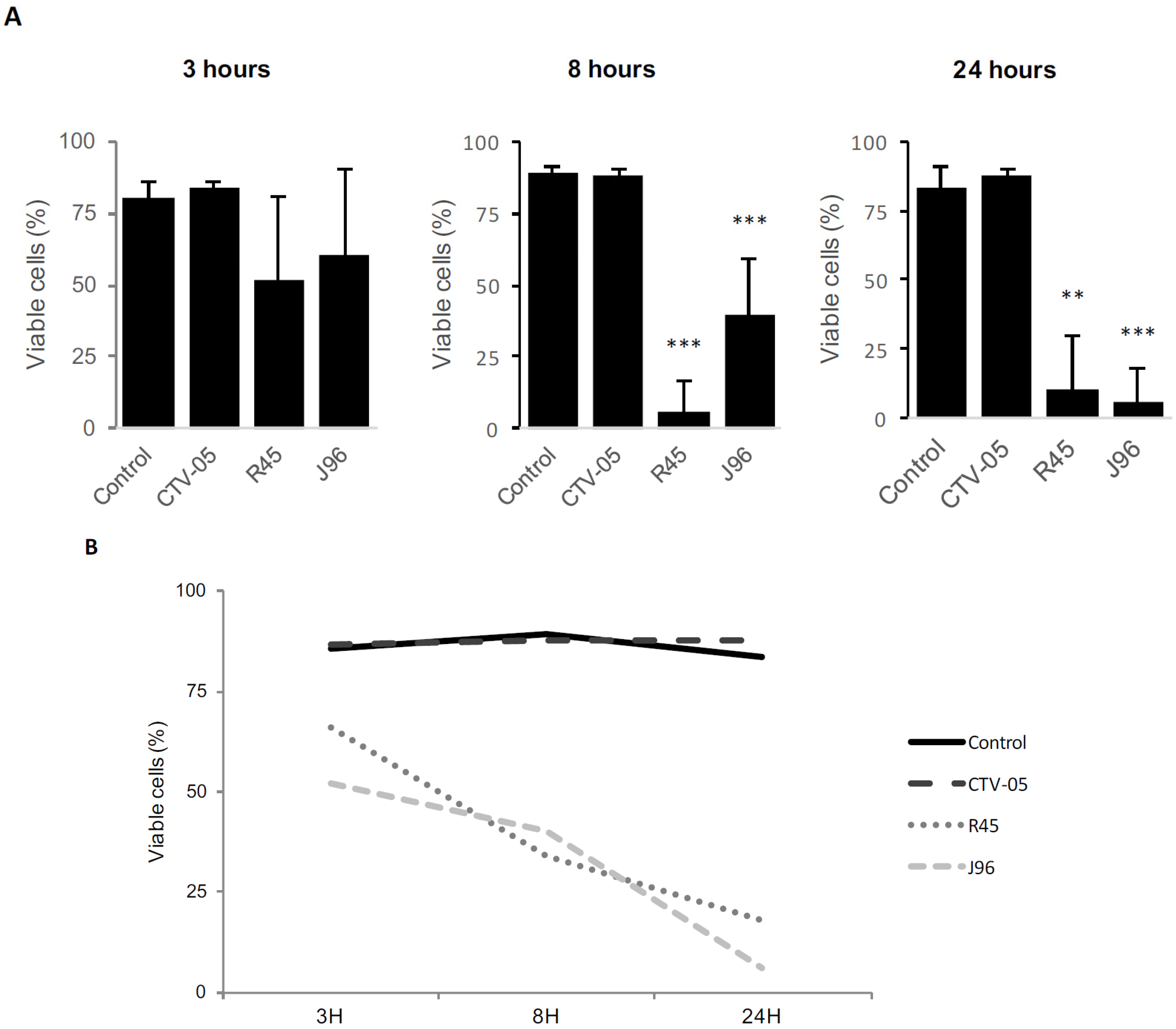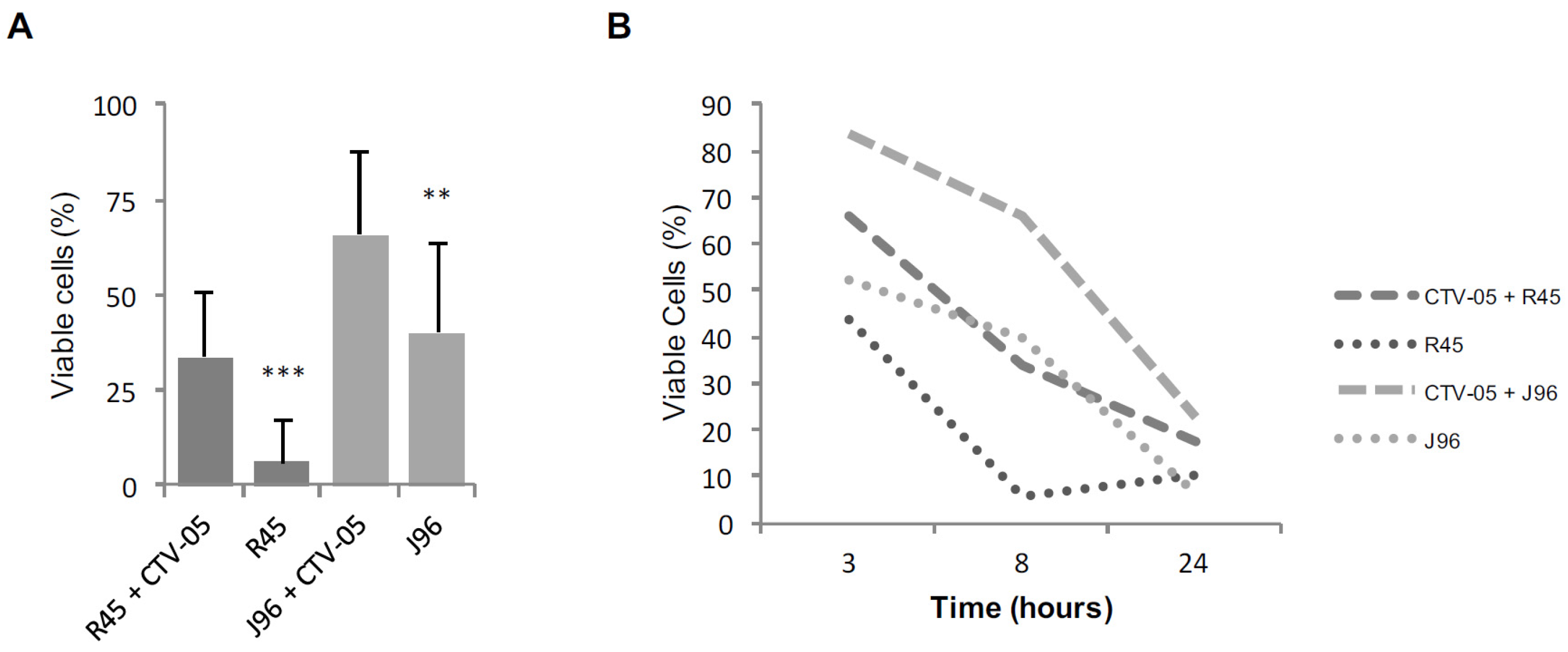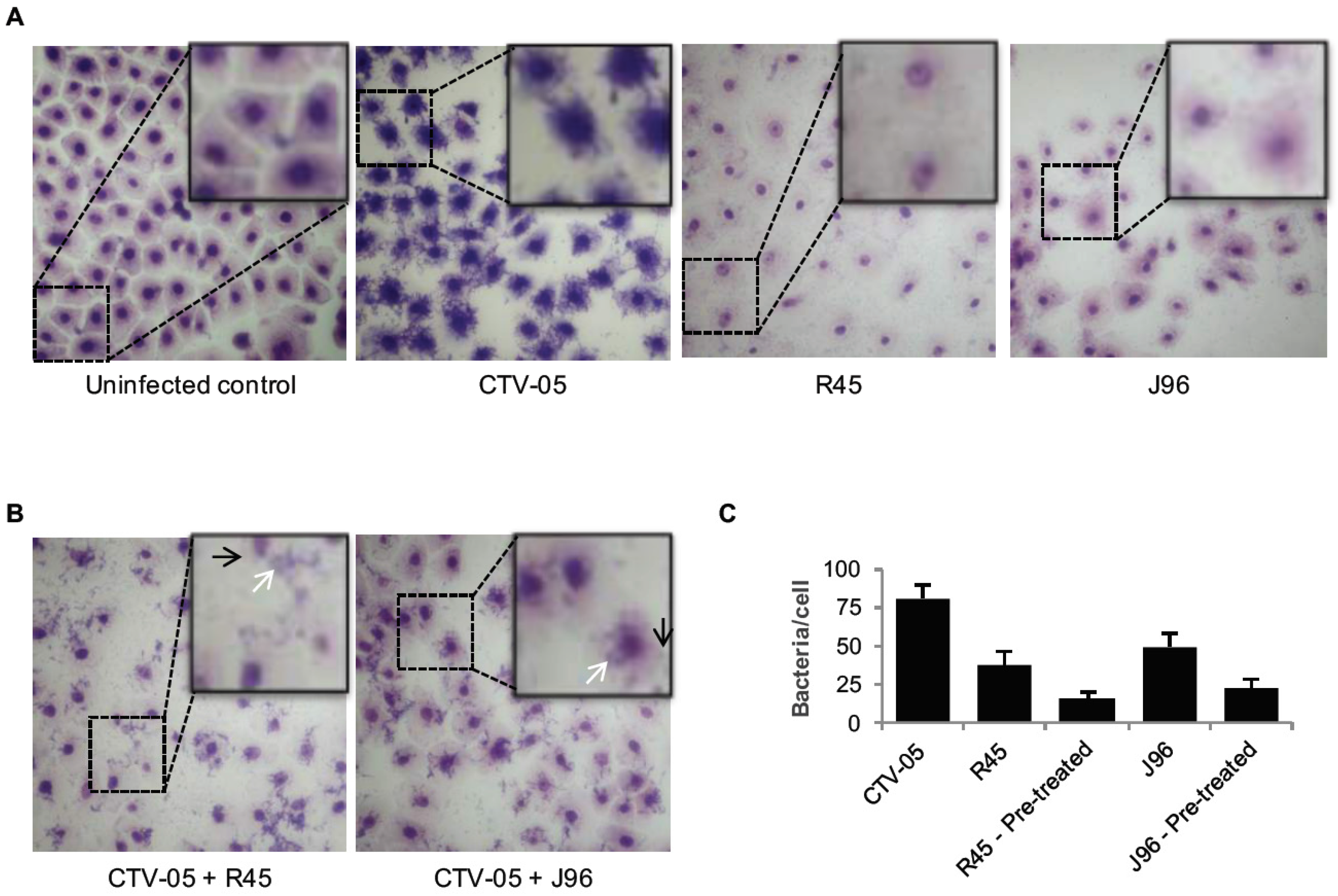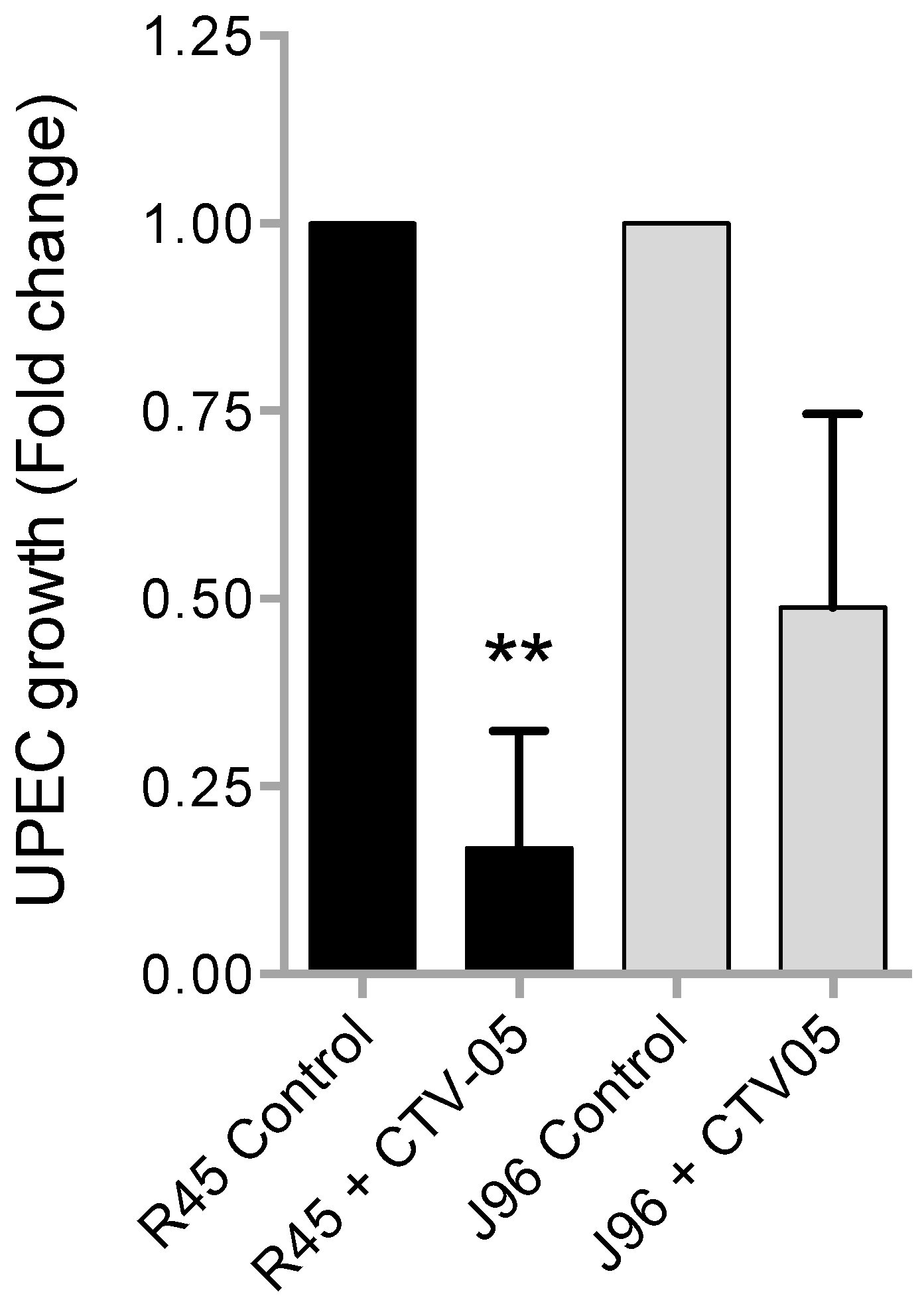Cytoprotective Effect of Lactobacillus crispatus CTV-05 against Uropathogenic E. coli
Abstract
:1. Introduction
2. Results and Discussion
2.1. Results
2.1.1. L. crispatus CTV-05 Reduces the Toxicity of UPEC Strains to Vaginal Epithelial Cells
2.1.2. L. crispatus CTV-05 Reduces the Adherence of UPEC to Vaginal Epithelial Cells
2.1.3. Lactobacillus crispatus CTV-05 Products in Spent Broth Filtered Supernatant Inhibit(s) the Growth of UPEC
2.1.4. L. crispatus CTV-05 Anti-Inflammatory Response in Vaginal Epithelial Cells
2.1.5. Clinical Data Suggest the Same Cytokine Expression Trend as In Vitro Data
2.2. Discussion
3. Experimental Section
4. Conclusions
Acknowledgments
Author Contributions
Conflicts of Interest
References
- Foxman, B. Epidemiology of urinary tract infections: Incidence, morbidity, and economic costs. Am. J. Med. 2002, 113, 5S–13S. [Google Scholar] [CrossRef]
- Foxman, B. The epidemiology of urinary tract infection. Nat. Rev. Urol. 2010, 7, 653–660. [Google Scholar] [CrossRef] [PubMed]
- Brumfitt, W.; Gargan, R.A.; Hamilton-Miller, J.M.T. Periurethral Enterobacterial carriage preceding urinary infection. Lancet 1987, 1, 824–826. [Google Scholar] [CrossRef]
- Hooton, T.M.; Fihn, S.D.; Johnson, C.; Roberts, P.L.; Stamm, W.E. Association between bacterial vaginosis and acute cystitis in women using diaphragms. Arch. Intern. Med. 1989, 149, 1932–1936. [Google Scholar] [CrossRef] [PubMed]
- Fihn, S.D.; Latham, R.H.; Roberts, P.; Running, K.; Stamm, W.E. Association between diaphragm use and urinary tract infection. JAMA 1985, 254, 240–245. [Google Scholar] [CrossRef] [PubMed]
- Antonio, M.A.; Hawes, S.E.; Hillier, S.L. The identification of vaginal Lactobacillus species and the demographic and microbiologic characteristics of women colonized by these species. J. Infect. Dis. 1999, 180, 1950–1956. [Google Scholar] [CrossRef] [PubMed]
- Ravel, J.; Gajer, P.; Abdo, Z.; Schneider, G.M.; Koenig, S.S.; McCulle, S.L.; Karlebach, S.; Gorle, R.; Russell, J.; Tacket, C.O. Vaginal microbiome of reproductive-age women. Proc. Natl. Acad. Sci. USA 2011, 108 (Suppl. S1), 4680–4687. [Google Scholar] [CrossRef] [PubMed]
- Vasquez, A.; Jakobsson, T.; Ahrné, S.; Forsum, U.; Molin, G. Vaginal lactobacillus flora of healthy Swedish women. J. Clin. Microbiol. 2002, 40, 2746–2749. [Google Scholar] [CrossRef] [PubMed]
- Hooton, T.M.; Roberts, P.L.; Stamm, W.E. Effects of recent sexual activity and use of a diaphragm on the vaginal microflora. Clin. Infect. Dis. 1994, 19, 274–278. [Google Scholar] [CrossRef] [PubMed]
- Foxman, B.; Gillespie, B.; Koopman, J.; Zhang, L.; Palin, K.; Tallman, P.; Marsh, J.V.; Spear, S.; Sobel, J.D.; Marty, M.J. Risk factors for second urinary tract infection among college women. Am. J. Epidemiol. 2000, 151, 1194–1205. [Google Scholar] [CrossRef] [PubMed]
- Beigi, R.H.; Wiesenfeld, H.C.; Hillier, S.L.; Straw, T.; Krohn, M.A. Factors associated with absence of H2O2-producing Lactobacillus among women with bacterial vaginosis. J. Infect. Dis. 2005, 191, 924–929. [Google Scholar] [CrossRef] [PubMed]
- Smith, H.S.; Hughes, J.P.; Hooton, T.M.; Roberts, P.; Scholes, D.; Stergachis, A.; Stapleton, A.; Stamm, W.E. Antecedent antimicrobial use increases the risk of uncomplicated cystitis in young women. Clin. Infect. Dis. 1997, 25, 63–68. [Google Scholar] [CrossRef] [PubMed]
- Al-Mayahie, S.M. Vaginal colonization by papG allele II+ Escherichia coli isolates from pregnant and nonpregnant women as predisposing factor to pyelonephritis. Infect. Dis. Obstet. Gynecol. 2013, 2013, 860402. [Google Scholar]
- Stapleton, A.; Nudelman, E.; Clausen, H.; Hakomori, S.; Stamm, W.E. Binding of uropathogenic Escherichia coli R45 to glycolipids extracted from vaginal epithelial cells is dependent on histo-blood group secretor status. J. Clin. Investig. 1992, 90, 965–972. [Google Scholar] [CrossRef] [PubMed]
- Melkumyan, A.R.; Priputnevich, T.V.; Ankirskaya, A.S.; Muraveva, V.V.; Lubasovskaya, L.A. Effects of Antibiotic Treatment on the Lactobacillus Composition of Vaginal Microbiota. Bull Exp. Biol. Med. 2015, 158, 766–768. [Google Scholar] [CrossRef] [PubMed]
- Bradshaw, C.S.; Morton, A.N.; Hocking, J.; Garland, S.M.; Morris, M.B.; Moss, L.M.; Horvath, L.B.; Kuzevska, I.; Fairley, C.K. High recurrence rates of bacterial vaginosis over the course of 12 months after oral metronidazole therapy and factors associated with recurrence. J. Infect. Dis. 2006, 193, 1478–1486. [Google Scholar] [CrossRef] [PubMed]
- Ocana, V.; Silva, C.; Nader-Macias, M.E. Antibiotic susceptibility of potentially probiotic vaginal lactobacilli. Infect. Dis. Obstet. Gynecol. 2006, 2006, 18182. [Google Scholar] [CrossRef] [PubMed]
- Reid, G.; Bruce, A.W.; Cook, R.L.; Llano, M. Effect on urogenital flora of antibiotic therapy for urinary tract infection. Scand. J. Infect. Dis. 1990, 22, 43–47. [Google Scholar] [CrossRef] [PubMed]
- Schilling, J.D.; Mulvey, M.A.; Vincent, C.D.; Lorenz, R.G.; Hultgren, S.J. Bacterial invasion augments epithelial cytokine responses to Escherichia coli through a lipopolysaccharide-dependent mechanism. J. Immunol. 2001, 166, 1148–1155. [Google Scholar] [CrossRef] [PubMed]
- Peltier, M.R.; Berlin, Y.; Tee, S.C.; Smulian, J.C. Does progesterone inhibit bacteria-stimulated interleukin-8 production by lower genital tract epithelial cells? J. Perinat. Med. 2009, 37, 328–333. [Google Scholar] [CrossRef] [PubMed]
- Otto, G.; Braconier, J.; Andreasson, A.; Svanborg, C. Interleukin-6 and disease severity in patients with bacteremic and nonbacteremic febrile urinary tract infection. J. Infect. Dis. 1999, 179, 172–179. [Google Scholar] [CrossRef] [PubMed]
- Gupta, K.; Chou, M.Y.; Howell, A.; Wobbe, C.; Grady, R.; Stapleton, A.E. Cranberry products inhibit adherence of p-fimbriated Escherichia coli to primary cultured bladder and vaginal epithelial cells. J. Urol. 2007, 177, 2357–2360. [Google Scholar] [CrossRef] [PubMed]
- Osset, J.; Bartolomé, R.M.; Andreu, A. Assessment of the capacity of Lactobacillus to inhibit the growth of uropathogens and block their adhesion to vaginal epithelial cells. J. Infect. Dis. 2001, 183, 485–491. [Google Scholar] [CrossRef] [PubMed]
- Czaja, C.A.; Stapleton, A.E.; Yarova-Yarovaya, Y.; Stamm, W.E. Phase I trial of a Lactobacillus crispatus vaginal suppository for prevention of recurrent urinary tract infection in women. Infect. Dis. Obstet. Gynecol. 2007, 2007, 35387. [Google Scholar] [CrossRef] [PubMed]
- Stapleton, A.E.; Au-Yeung, M.; Hooton, T.M.; Fredricks, D.N.; Roberts, P.L.; Czaja, C.A.; Yarova-Yarovaya, Y.; Fiedler, T.; Cox, M.; Stamm, W.E. Randomized, placebo controlled phase 2 trial of a Lactobacillus crispatus probiotic given intravaginally for prevention of recurrent urinary tract infection. Clin. Infect. Dis. 2011, 52, 1212–1217. [Google Scholar] [CrossRef] [PubMed]
- Tao, Y.; Drabik, K.A.; Waypa, T.S.; Musch, M.W.; Alverdy, J.C.; Schneewind, O.; Chang, E.B.; Petrof, E.O. Soluble factors from Lactobacillus GG activate MAPKs and induce cytoprotective heat shock proteins in intestinal epithelial cells. Am. J. Physiol. Cell Physiol. 2006, 290, C1018–C1030. [Google Scholar] [CrossRef] [PubMed]
- Yan, F.; Cao, H.; Cover, T.L.; Whitehead, R.; Washington, M.K.; Polk, D.B. Soluble proteins produced by probiotic bacteria regulate intestinal epithelial cell survival and growth. Gastroenterology 2007, 132, 562–575. [Google Scholar] [CrossRef] [PubMed]
- Vallor, A.C.; Antonio, M.A.; Hawes, S.E.; Hillier, S.L. Factors associated with acquisition of, or persistent colonization by, vaginal lactobacilli: Role of hydrogen peroxide production. J. Infect. Dis. 2001, 184, 1431–1436. [Google Scholar] [CrossRef] [PubMed]
- Presti, I.; D’Orazio, G.; Labra, M.; la Ferla, B.; Mezzasalma, V.; Bizzaro, G.; Giardina, S.; Michelotti, A.; Tursi, F.; Vassallo, M. Evaluation of the probiotic properties of new Lactobacillus and Bifidobacterium strains and their in vitro effect. Appl. Microbiol. Biotechnol. 2015, 99, 5613–5626. [Google Scholar] [CrossRef] [PubMed]
- Likotrafiti, E.; Tuohy, K.M.; Gibson, G.R.; Rastall, R.A. An in vitro study of the effect of probiotics, prebiotics and synbiotics on the elderly faecal microbiota. Anaerobe 2014, 27, 50–55. [Google Scholar] [CrossRef] [PubMed]
- Russell, J.B.; Diez-Gonzalez, F. The effects of fermentation acids on bacterial growth. Adv. Microb. Physiol. 1998, 39, 205–234. [Google Scholar] [PubMed]
- Imlay, J.A. Diagnosing oxidative stress in bacteria: Not as easy as you might think. Curr. Opin. Microbiol. 2015, 24, 124–131. [Google Scholar] [CrossRef] [PubMed]
- Keyer, K.; Imlay, J.A. Superoxide accelerates DNA damage by elevating free-iron levels. Proc. Natl. Acad. Sci. USA 1996, 93, 13635–13640. [Google Scholar] [CrossRef] [PubMed]
- Ocana, V.S.; De Ruiz Holgado, A.A.P.; Nader-Macias, M.E. Characterization of a bacteriocin-like substance produced by a vaginal Lactobacillus salivarius strain. Appl. Environ. Microbiol. 1999, 65, 5631–5635. [Google Scholar] [PubMed]
- Stoyancheva, G.; Marzotto, M.; Dellaglio, F.; Torriani, S. Bacteriocin production and gene sequencing analysis from vaginal Lactobacillus strains. Arch. Microbiol. 2014, 196, 645–653. [Google Scholar] [CrossRef] [PubMed]
- Rizzo, A.; Losacco, A.; Carratelli, C.R. Lactobacillus crispatus modulates epithelial cell defense against Candida albicans through Toll-like receptors 2 and 4, interleukin 8 and human beta-defensins 2 and 3. Immunol. Lett. 2013, 156, 102–109. [Google Scholar] [CrossRef] [PubMed]
- Griet, M.; Zelaya, H.; Mateos, M.V.; Salva, S.; Juarez, G.E.; de Valdez, G.F.; Villena, J.; Salvador, G.A.; Rodriguez, A.V. Soluble factors from Lactobacillus reuteri CRL1098 have anti-inflammatory effects in acute lung injury induced by lipopolysaccharide in mice. PLoS ONE 2014, 9, e110027. [Google Scholar] [CrossRef] [PubMed] [Green Version]
- Hedges, S.; Svanborg, C. The mucosal cytokine response to urinary tract infections. Int. J. Antimicrob. Agents 1994, 4, 89–93. [Google Scholar] [CrossRef]
- Steele, C.; Fidel, P.L., Jr. Cytokine and chemokine production by human oral and vaginal epithelial cells in response to Candida albicans. Infect. Immun. 2002, 70, 577–583. [Google Scholar] [CrossRef] [PubMed]
- Marconi, C.; Donders, G.G.; Parada, C.M.; Giraldo, P.C.; da Silva, M.G. Do Atopobium vaginae, Megasphaera sp. and Leptotrichia sp. change the local innate immune response and sialidase activity in bacterial vaginosis? Sex Transm. Infect. 2013, 89, 167–173. [Google Scholar] [CrossRef] [PubMed]
- Weissenbacher, T.; Walter, C.; Mylonas, I.; Scholz, C.; Gingelmaier, A.; Friese, K. Interleukin-6, interleukin-10 and interleukin-12 in vaginal fluid from women with bacterial vaginosis. Arch. Gynecol. Obstet. 2010, 281, 77–80. [Google Scholar] [CrossRef] [PubMed]
- Mitchell, C.M.; Balkus, J.; Agnew, K.J.; Cohn, S.; Luque, A.; Lawler, R.; Coombs, R.W.; Hitti, J.E. Bacterial vaginosis, not HIV, Is primarily responsible for increased vaginal concentrations of proinflammatory cytokines. AIDS Res. Hum. Retrovir. 2008, 24, 667–671. [Google Scholar] [CrossRef] [PubMed]
- Marconi, C.; Santos-Greatti, M.M.; Parada, C.M.; Pontes, A.; Pontes, A.G.; Giraldo, P.C.; Donders, G.G.; da Silva, M.G. Cervicovaginal levels of proinflammatory cytokines are increased during chlamydial infection in bacterial vaginosis but not in lactobacilli-dominated flora. J. Low Genit. Tract. Dis. 2014, 18, 261–265. [Google Scholar] [CrossRef] [PubMed]





| Control | CTV-05 | J96 | R45 | pa | pb | pc | |
|---|---|---|---|---|---|---|---|
| IL-1β | 2.49 (0.00–15.7) | 4.75 (0.54–11.3) | 59.5 (2.85–101) | 57.4 (1.89–101) | NS | * | * |
| IL-6 | 1.16 (0.00–2.56) | 2.35 (0.00–4.75) | 1.69 (0.41–5.96) | 0.95 (0.00–2.78) | NS | NS | NS |
| IL-10 | 5.25 (0.00–11.3) | 9.00 (0.58–51.0) | 20.4 (10.9–37.8) | 14.2 (8.38–32.8) | NS | NS | NS |
| R45 | R45 + CTV-05 | p | J96 | J96 + CTV-05 | p | |
|---|---|---|---|---|---|---|
| IL-1β | 57.4 (1.89–101) | 35.1 (2.13–70.5) | NS | 59.5 (2.85–101) | 14.7 (2.37–68.8) | * |
| IL-6 | 0.95 (0.00–2.78) | 1.07 (0.00–2.48) | NS | 1.69 (0.41–5.96) | 1.28 (0.00–3.35) | NS |
| IL-10 | 14.20 (8.375–32.83) | 24.063 (3.38–33.25) | NS | 20.3 (10.9–37.8) | 23.5 (9.62–64.9) | NS |
© 2016 by the authors; licensee MDPI, Basel, Switzerland. This article is an open access article distributed under the terms and conditions of the Creative Commons by Attribution (CC-BY) license (http://creativecommons.org/licenses/by/4.0/).
Share and Cite
Butler, D.S.C.; Silvestroni, A.; Stapleton, A.E. Cytoprotective Effect of Lactobacillus crispatus CTV-05 against Uropathogenic E. coli. Pathogens 2016, 5, 27. https://doi.org/10.3390/pathogens5010027
Butler DSC, Silvestroni A, Stapleton AE. Cytoprotective Effect of Lactobacillus crispatus CTV-05 against Uropathogenic E. coli. Pathogens. 2016; 5(1):27. https://doi.org/10.3390/pathogens5010027
Chicago/Turabian StyleButler, Daniel S. C., Aurelio Silvestroni, and Ann E. Stapleton. 2016. "Cytoprotective Effect of Lactobacillus crispatus CTV-05 against Uropathogenic E. coli" Pathogens 5, no. 1: 27. https://doi.org/10.3390/pathogens5010027






